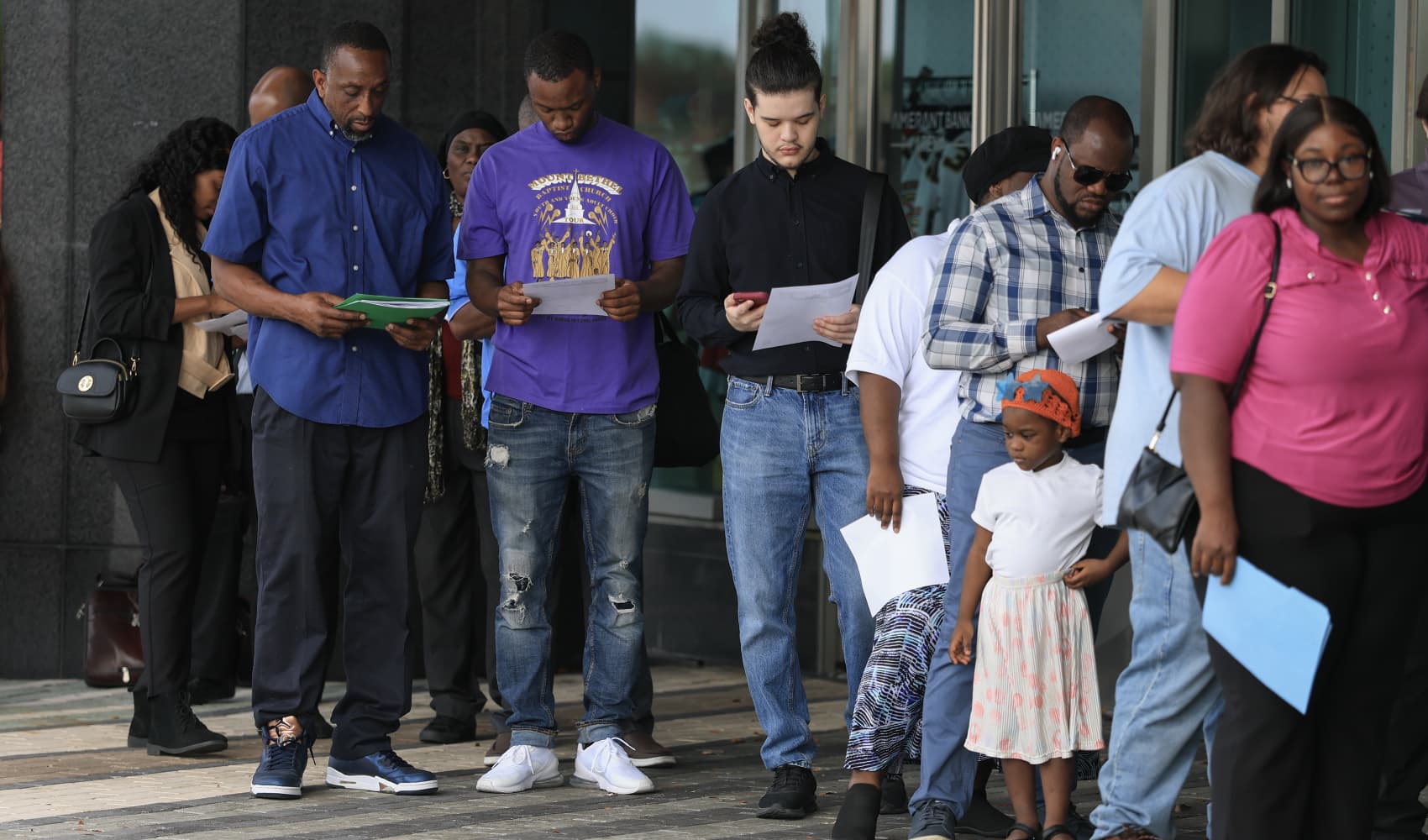Jobless Claims Spike: Is Economic Trouble Brewing?
Jobless Claims Spike: Economic Storm Clouds Gather?
Introduction: A Wake-Up Call for the Economy?
Hold on to your hats, folks! It seems like the economic winds are shifting. Last week, we got a bit of a jolt when the latest jobless claims data came in, and it wasn't exactly sunshine and rainbows. Initial unemployment claims surged, exceeding expectations and raising some eyebrows about the health of our economy. Are we looking at just a blip on the radar, or is this a sign of deeper troubles brewing? Let's dive in and explore what this means for you, me, and the overall economic landscape.
Unemployment Claims Surge: The Headline Numbers
The cold, hard facts are these: First-time filings for unemployment insurance totaled a seasonally adjusted 241,000 for the week ended April 26th. That's up 18,000 from the previous week, and significantly higher than the 225,000 that economists were anticipating. Think of it like this: imagine you're planning a party for 225 guests, and suddenly 241 show up. You're caught a little off guard, right? That's how economists felt about these numbers.
Continuing Claims: A Broader View of Layoff Trends
Now, initial claims only tell part of the story. To get a more comprehensive understanding, we need to look at continuing claims. These represent the number of people already receiving unemployment benefits. The data here paints a similar picture: Continuing claims rose to 1.92 million, an increase of 83,000, reaching their highest level since November 13, 2021. This suggests that people aren't just losing their jobs; they're also having a harder time finding new ones. That's not a good sign.
Digging Deeper: Why the Unexpected Increase?
So, what's behind this unexpected surge in jobless claims? There's no single answer, but several factors could be at play. Maybe companies are starting to feel the pinch of higher interest rates, leading them to cut costs through layoffs. Perhaps certain sectors are experiencing a slowdown, impacting employment in those areas. Or maybe it's simply a statistical anomaly – a random fluctuation that doesn't necessarily indicate a long-term trend. We need more data to draw firm conclusions.
Interest Rates and Their Impact on Job Security
The Federal Reserve's aggressive campaign to combat inflation by raising interest rates could be a contributing factor. Higher interest rates make it more expensive for businesses to borrow money, which can slow down investment and hiring. It's like trying to run a marathon with ankle weights – you can still do it, but it's going to be a lot harder. As borrowing becomes more costly, some companies may be forced to reduce their workforce to stay afloat.
Sector Slowdowns: Which Industries Are Feeling the Heat?
Are specific industries particularly vulnerable right now? It's possible. For example, the tech sector has already seen significant layoffs in recent months. Other sectors, like housing or manufacturing, could also be facing headwinds due to rising interest rates or slowing demand. Keeping an eye on industry-specific data can provide valuable insights into the overall health of the job market.
Statistical Noise or a Genuine Trend?
It's important to remember that economic data can be noisy. Sometimes, a single data point doesn't tell the whole story. It could be a one-off event or a statistical quirk. That's why economists often look at trends over time rather than focusing on individual data releases. We need to see if this increase in jobless claims persists in the coming weeks to determine if it's a genuine trend or just a temporary blip.
The Labor Market: Still Relatively Strong, But Cracks Are Showing
While the latest jobless claims data is concerning, it's important to put it in context. The labor market is still relatively strong, with unemployment rates near historic lows. However, these numbers suggest that some cracks may be starting to appear. It's like a house that looks solid from the outside but has some cracks in the foundation. We need to monitor the situation closely to see if these cracks widen.
Inflation: The Uninvited Guest Still Lingering
Inflation remains a key concern. While it has come down from its peak, it's still above the Federal Reserve's target. This puts pressure on the Fed to continue raising interest rates, which could further slow down the economy and lead to more layoffs. It's a delicate balancing act – trying to tame inflation without pushing the economy into a recession.
What Does This Mean for You?
So, how does all of this affect you personally? Well, if you're worried about your job security, it might be a good idea to brush up on your skills, network with colleagues, and start building an emergency fund. Think of it as preparing for a potential storm – you hope it doesn't come, but you're better off being ready just in case. Also, stay informed about the economic developments in your specific industry.
Building an Emergency Fund: A Safety Net in Uncertain Times
An emergency fund is like a financial safety net. It provides a cushion in case you lose your job or face unexpected expenses. Aim to save at least three to six months' worth of living expenses. This can give you peace of mind and allow you to weather any potential economic storms.
Upskilling and Networking: Investing in Your Future
In today's rapidly changing job market, it's more important than ever to continuously upskill and network. Take online courses, attend industry events, and connect with people in your field. This can help you stay relevant and increase your chances of finding a new job if you need to.
The Federal Reserve's Next Move: A Critical Decision
All eyes are now on the Federal Reserve. Will they continue to raise interest rates aggressively, or will they pause to assess the impact of their previous hikes? Their decision will have a significant impact on the economy and the job market. It's like watching a chess game – every move the Fed makes has consequences.
The Road Ahead: Navigating Economic Uncertainty
The economic outlook remains uncertain. There are signs of strength, but also signs of weakness. The key is to stay informed, be prepared, and focus on what you can control. We may be in for a bumpy ride, but by staying vigilant, we can navigate these uncertain times.
Conclusion: Staying Informed and Prepared
The recent surge in jobless claims serves as a reminder that the economy is constantly evolving. While the labor market remains relatively strong, these numbers suggest that some challenges may lie ahead. It's crucial to stay informed about economic developments, build a financial safety net, and invest in your skills to navigate any potential economic turbulence. Remember, knowledge is power, and preparation is key.
Frequently Asked Questions (FAQs)
Here are some frequently asked questions about the recent surge in jobless claims:
Q1: What exactly are initial jobless claims?
Initial jobless claims are a weekly measure of the number of people filing for unemployment benefits for the first time. It's an indicator of how many people are newly unemployed.
Q2: Why is an increase in jobless claims considered a bad sign?
An increase in jobless claims suggests that more people are losing their jobs, which could indicate a weakening economy. It can also lead to decreased consumer spending and slower economic growth.
Q3: What are continuing jobless claims and how are they different from initial claims?
Continuing jobless claims reflect the number of people who are already receiving unemployment benefits. Unlike initial claims, they provide a broader view of unemployment trends over time.
Q4: Does this mean a recession is definitely coming?
Not necessarily. While an increase in jobless claims can be a warning sign, it doesn't automatically mean a recession is imminent. Other economic factors, such as consumer spending, inflation, and business investment, also play a crucial role.
Q5: What can I do to protect myself financially during economic uncertainty?
Building an emergency fund, upskilling to increase your job security, and diversifying your investments are all good strategies to protect yourself financially during uncertain economic times. It's about being prepared for various scenarios.

